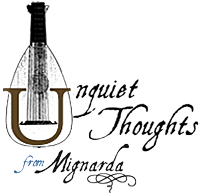Collaborative Shakespeare II
 Having written and posted a piece on Shakespeare and his collaborators in great haste, we find it necessary to add a few additional points that may have been glossed over in the previous post.
Having written and posted a piece on Shakespeare and his collaborators in great haste, we find it necessary to add a few additional points that may have been glossed over in the previous post.
The first point of clarification has to do with John Florio, pictured to the left, and his participation in editing material in Shakespeare’s First Folio of 1623. Significantly, Florio was also brother-in-law to Samuel and John Danyel, John being the noted lutenist-composer and Samuel the noted poet. Florio and both brothers were luminaries among the circle who explored the themes of melancholy, light and darkness, patronized by Lucy, Countess of Bedford, a circle that also included John Donne, Edmund Spenser, Ben Jonson, and John Dowland, to name a few.
Florio is an important literary figure in his own right, and his association with the Danyels and the Countess of Bedford’s musical/literary circle has been mentioned in previous posts, including our feature on the Willow Song. Perhaps the topic will be featured in greater depth in a future post.
The second topic we address has to do with a computer analysis conducted years ago, a study that purportedly puts the matter of Shakespeare authorship to rest. As far as we can tell, this study is titled, Was the Earl of Oxford the True Shakespeare? A Computer-Aided Analysis by Ward Elliott and Robert Valenza, Claremont McKenna College, dated April 7, 1991.
While one does not wish to disparage the authors’ research methods, model for analysis, nor their conclusions, it is important to note that any study that attempts to take something as ephemeral as language, even in the form of the written word, and establish parameters to analyze the use of that language by occurrence of keywords or phrases is doomed to produce results that must focus on the mechanical aspects rather than quality of artistic expression.
Turning great prose and poetry into data may excite those with an analytical bent, but language is full of nuance, and keywords or patterns that are extracted from their context and subjected to analysis will produce results that utterly destroy the meaning and the subtlety of the whole, turning a poem into nothing more than a collection of letters and words. It’s likely that the authors of the study in question knew this at the outset, but proceeded with the task at hand with the tools available to them and with the best of intentions.
Elliott and Valenza’s study divided segments of text into blocks and counted 52 keywords in each block, choosing “middling common words such as ‘about’, ‘again’, ‘ways’, and ‘words’”. Rather than counting keyword occurrences, the study measured:
“…patterns of deviation from a writer’s normal rates of word frequency. [The modes] measure the way an author uses, or avoids using, words together. In Shakespeare’s poems, modal analysis has revealed a few very strong, characteristic modes, quickly tailing off into many weak modes. All 90 blocks of Shakespeare’s poems, and a block or two of sonnets taken from his plays, show the same characteristic pattern, while many blocks of other authors do not.”
The authors of the study examined hyphenated compound words (HCWs) and total relative clauses (TRCs), and produced rudimentary graphs that depict line-ending trends in Shakespeare’s plays, and other factors such as the frequency of feminine endings. Conclusions were presented objectively:
“Our conclusion from the Clinic was that Shakespeare fit within a fairly narrow, distinctive profile under our best tests. If his poems were written by a committee, it was a remarkably consistent committee. If they were written by any of the claimants we tested, it was a remarkably inconsistent claimant…We do not claim to have said the last word on this subject, nor to have solved the Shakespeare authorship mystery. But, if it strains credulity to suppose that Will Shakspere, the Stratford grain dealer, could have written Shakespeare’s poems and plays, it also strains credulity to suppose that people like [the Earl of] Oxford, with entirely different stylistic idiosyncrasies from Shakespeare, could have been the true authors of his poems and plays.”
Again, the authors of the study appear to have constructed a reasonable model for analysis with the tools available to them at the time, and they presented their results in an objective manner. But even the authors of the study will admit that this does in no way represent the final word on the issue. There are far too many factors to consider to say that this or any other mechanical analysis of the works of Shakespeare will offer the final word on the identity of the author.
If John Florio was indeed responsible for editing a substantial portion of the text in the First Folio of 1623, then any objective researcher will admit that the source material has been tainted beyond recognition. There survives exactly zero text in Shakespeare’s hand in manuscript form, so we will never have an untainted sample to establish a baseline of text by the “real” Shakespeare in order to compare. Those of us who edit early music from historical source material know this to be true. When will the literary experts catch on?

Trackbacks & Pingbacks